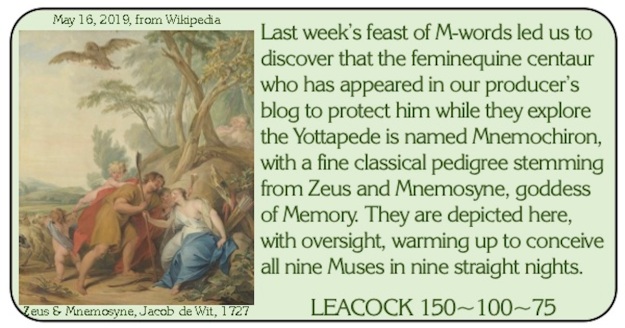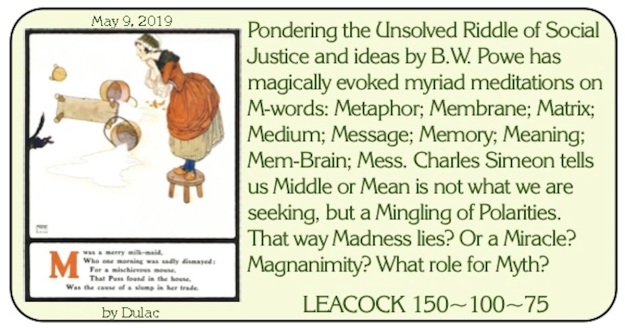A Dark Tower, a Slug-Horn, a Charged Global Membrane, two star-nosed moles in aspect, a labyrinth placed in a middling Canadian city named Mariposa, citizens to walk it and leaders to help them, a bag-full of clobs for clobbering bawls, a yottapede, a centauress with an uneasy rider. Have any of these proved of any value in locating the wild Unsolved Riddle of Social Justice and imagining the creature and its natural habitat, so that it can be tamed and put to work? I think it is time to assess the progress of these three quite different work parties.
Two of them have located the creature, or think they have. The two moles, burrowing their way through the ooze of the Charged Global-Perceptual Membrane-Medium-MemBrain, or Chooze for short, looking for the Dark Tower, believing it to be the most likely habitat, have discovered that the Chooze is the Dark Tower, and that all the confusion, perplexity, fragmentation, incompleteness, inconclusiveness, and resulting anxiety are both the Unsolved Riddle of Social Justice itself, and the essence of its nature. The Chooze is a Puddle of Muddle, they would say if they were being epigrammatic, so is the UROSJ, and so are the people caught up in it. If that is so, then pretending otherwise, as ideologies of all kinds tend to prefer, may be the worst possible entry into the necessary tasks of taming and putting to work.
The Labyrinth Walkers appear to have discovered what it means to blow the Slug-Horn, which is odd, because that question apparently never crossed their minds in the whole half-labyrinth they have walked so far. In fact, the Slug-Horn has until now been the exclusive property of the Dark Tower party. The Walkers came upon it when they got to the Centre. They think that to blow it means to be epigrammatic, to speak in “slogans”, these and slug-horns being the same thing etymologically. Childe Roland’s slogan was “Childe Roland to the Dark Tower Came”. Theirs is:
“DAUNTLESSLY, STEP-BY-STEP, BOTH ONE AT A TIME AND ALL TOGETHER!”
This they intend to employ as they work their way back out of the labyrinth. When they emerge from where they came in, but of course going in the opposite direction, they expect to have tamed the UROSJ, so that it can be put to work.
Mnemochiron, the feminequine centaur, and her Uneasy Rider, who narrates in the first person and therefore may sit in the same relation to the writer as does the narrator in Sunshine Sketches of a Little Town, which may or may not be a close one, believe they have discovered the UROSJ itself, in the person of the Yottapede. Mnemochiron’s magic is her ability to move around inside the creature without being sucked into it, as Uneasy Rider would be on his own.
So you see, it has taken all three parties to locate the UROSJ and equip us to tame it and put it to work. The UROSJ, formed as the Yottapede, swims or wades in a puddle of muddle called the Chooze. Mnemochiron is able to carry Uneasy Rider safely into its inwards where it can be carefully explored. The two moles in aspect are able to burrow sensationally through the Chooze, and thus explore it. The Walkers maintain their steady undulating course through the Labyrinth, clobbering the bawls encountered,—bawls being little globes, or globs, of Inertia,—with the appropriate clob from among the fourteen carried, depending on the lie of the bawl and distance to the whole:
Pluraliser :: used for recognizing Pluralism;
Puzzler :: used for recognizing Unsolved Riddles;
Coherenator :: used for overcoming Fragmentation;
Completer :: used for overcoming Incompleteness;
Concluder :: used (always most carefully) for overcoming Inconclusiveness;
Congruver :: used for reconciling incongruous juxtapositions;
Both-Ander :: used for coping with hazards of the either-or kind;
Knowledge :: should always be complemented by application of the Both-Ander;
Imagination :: the indispensable clob; no inertia can be overcome without it;
Compassion :: clob for choosing the appropriate direction;
Humour :: clob for dealing with inherent imperfections or difficult lies;
Conversation :: everyday, working clob;
Negotiation :: clob for overcoming conflicting inertias;
Education :: clob for learning the game and basic clobbering skills.
I think this whole system needs to be brought together, the parties introduced to each other and allowed to join forces. To do that I propose a device first suggested by Jonathan Swift in Gulliver’s Travels, a floating airborne island he called Laputa. I propose to suspend the Chooze with its inhabiting Yottapede as a mega-glob, or “meglob”, floating above Mariposa in Laputan fashion with differences where necessary. The two moles in aspect, whose names can be Stebu and Pedub, Mnemochiron, and Uneasy Rider can act as scouts circulating within the meglob. I will assign the nine Muses to carry their observations and suggestions down to the walkers below. We’ll have four scouts, nine Walkers supported by Mayor Josie Smith, nine Muses supported by their mother Mnemosyne. The Labyrinth and the Chooze I will make coextensive, so that the Walkers can theoretically encompass the entire meglob on their way out. When the scouts identify a particular bawl, or glob of Inertia, they will point it out to one of the Muses, who will flutter down like butterflies to tip off the Walkers of Mariposa, who will clobber it with the appropriate clob, blowing the Slug-Horn with each stroke to control line and distance. That’s the general idea, to start with. We’ll see how it works out.
To name and describe all possible bawls and clobbers would far exceed the quantitative capacities of this metaphorical exercise. I will therefore arrange the labyrinth into a course of eighteen (18) representative wholes. When the Walkers have clobbered their way around the whole thing, we will declare the game to be over, the Unsolved Riddle of Social Justice tamed so that it can be put to work. Our metaphors have worked so well so far that I have no doubt of their success. They need only proceed
“DAUNTLESSLY, STEP-BY-STEP, BOTH ONE AT A TIME AND ALL TOGETHER!”



 By gripping with the knees, of course. To wrap one’s arms around her waist for greater stability might be considered fresh; any jostling could cause extreme embarrassment. When all blushingly I put the problem to her, she gave me permission to grip her by the shoulders, with a request that I should massage the muscles from time to time, as the effort of constantly considering Unsolved Riddles first on the one hand and then on the other was often tiring. I did offer to walk alongside, but she thought that we would travel more quickly if I rode, and if matters came to combat we would gain from her speed and manoeuvrability. As we approached the Yottapede we soon learned the wisdom of this arrangement.
By gripping with the knees, of course. To wrap one’s arms around her waist for greater stability might be considered fresh; any jostling could cause extreme embarrassment. When all blushingly I put the problem to her, she gave me permission to grip her by the shoulders, with a request that I should massage the muscles from time to time, as the effort of constantly considering Unsolved Riddles first on the one hand and then on the other was often tiring. I did offer to walk alongside, but she thought that we would travel more quickly if I rode, and if matters came to combat we would gain from her speed and manoeuvrability. As we approached the Yottapede we soon learned the wisdom of this arrangement.